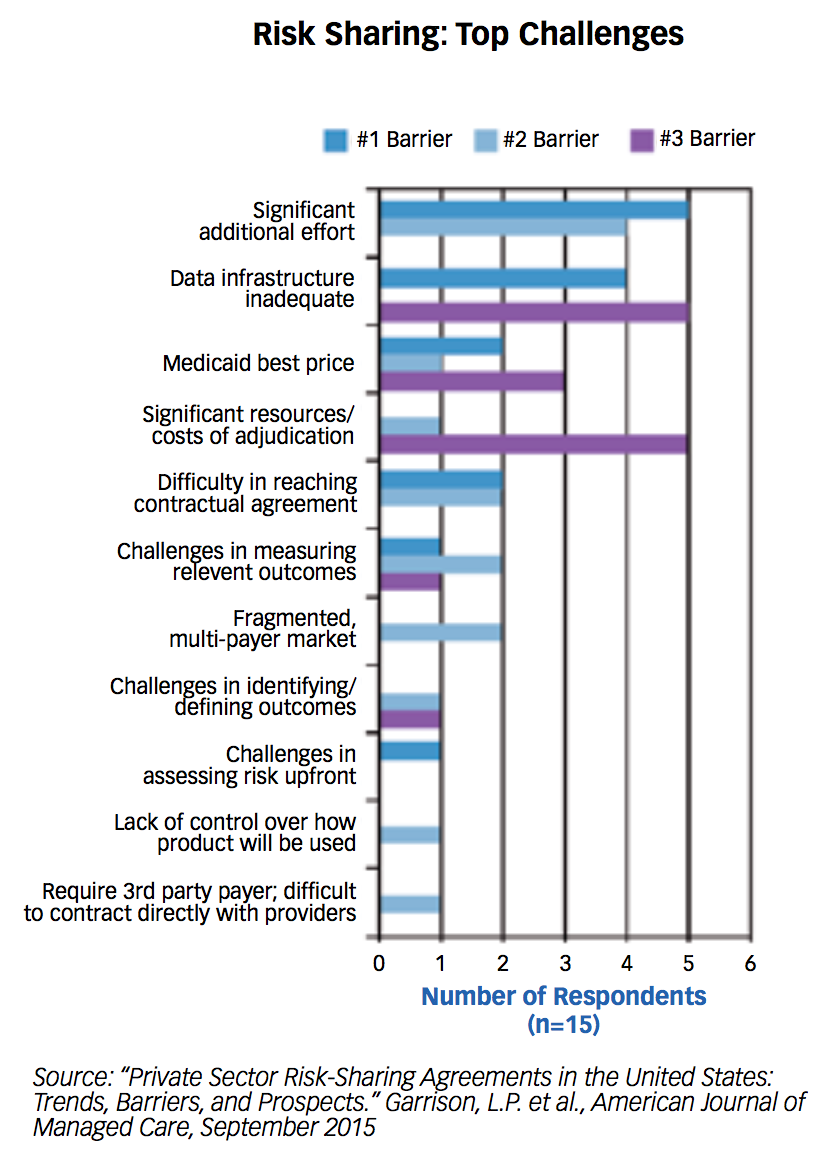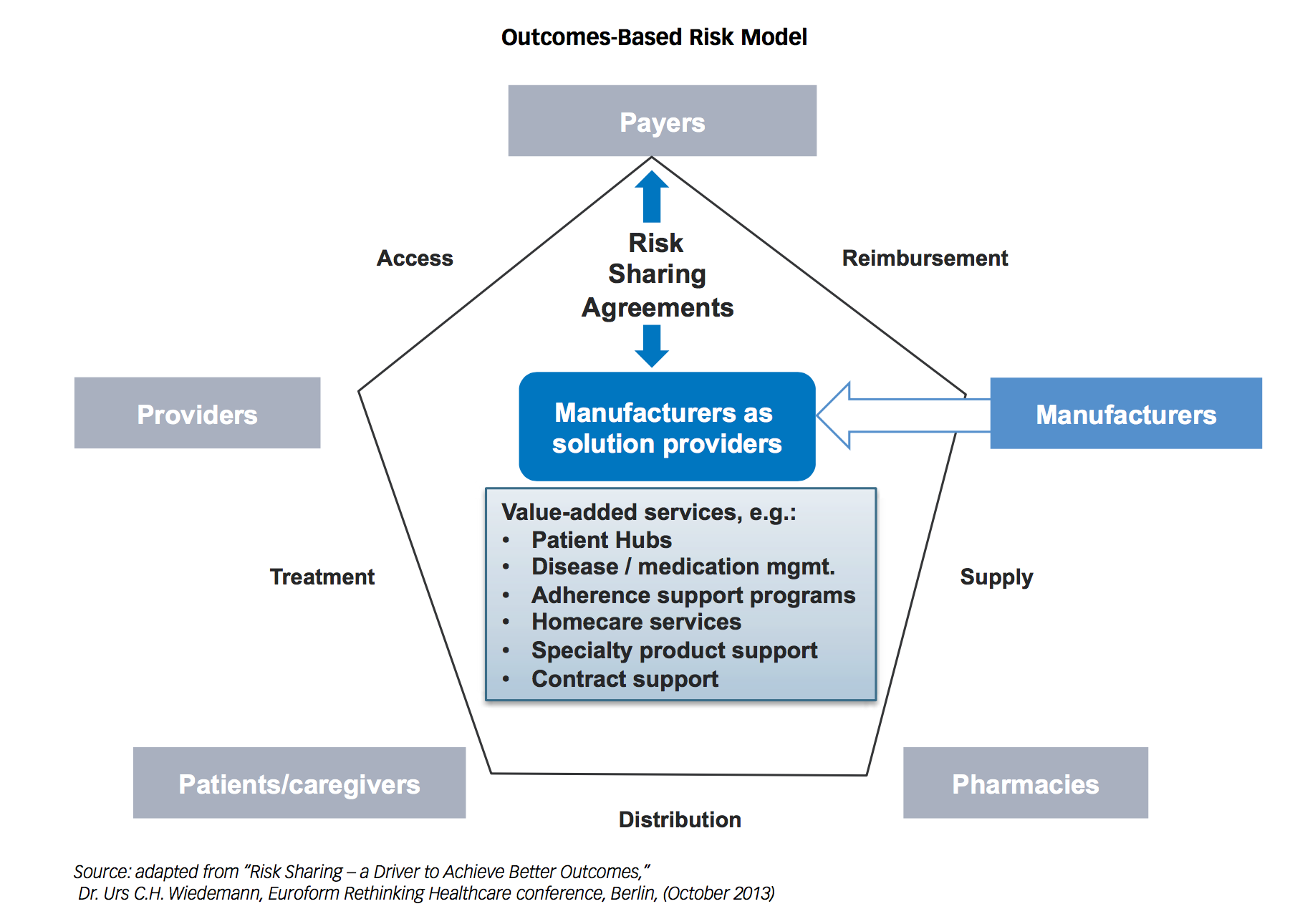Raising the Stakes On Value-Based Pricing
Pharmaceutical Executive
The importance of betting on outcomes, not simply risk sharing, when implementing pharma-payer arrangements. .
Even before Martin Shkreli, former CEO of Turing Pharmaceuticals, became the poster child for price-gouging with an overnight price increase of roughly 5,000% on Daraprim, the US pharmaceuticals industry was primed for a sanity check on its pricing practices. But Shkreli was simply the most notorious player in the pharmaceutical price game, as 2015 saw several instances of purportedly aggressive pricing practices.
In the US, the growth in prescription drug prices has exceeded inflation rates over many years, raising the ire of consumers, policymakers, and politicians. As a result, pharmaceutical manufacturers will increasingly need to demonstrate value to global payers and health technology assessment (HTA) bodies as a prerequisite for premium prices and/or significant price increases.
Reframing risk sharing
One approach to ensuring value is a form of “risk-sharing,” wherein the cost of a therapy is linked directly to patient outcomes, as with a performance guarantee. Unfortunately, the potential for such outcomes-based, risk-sharing arrangements to deliver on the promise of value has been hindered by contract complexity, data limitations, monitoring issues, price reporting regulations, and other implementation hurdles.
With drug pricing practices now a cause célèbre in the US, it is imperative for pharmaceutical manufacturers to address these challenges as part of their value proposition. Making outcomes-based arrangements simple and workable for payers

will be critical to mitigate additional price regulation and access restrictions that are being proposed by public and private payers, politicians, and other stakeholders.
Innovative or alternative pricing refers to a wide range of arrangements between manufacturers and payers, including price-volume agreements, capitation agreements, and patient access schemes (PAS); performance-based risk-sharing arrangements (PBRSA); pay-for-performance (P4P); coverage with evidence development (CED); outcomes-based guarantees; etc.
From arrangements that are mainly financial to those that limit total cost or utilization, or guarantee outcomes, the aim is to help allay payer concerns about excessive cost and utilization, while ensuring improvements in patient outcomes. These arrangements have been the subject of much attention both within the industry and among academics.
Implementation hurdles
One recent review of risk-sharing agreements in the US focused specifically on current trends, success factors, and challenges in the use of outcomes-based arrangements. The study reported that only 18 outcomes-based arrangements have been implemented (i.e., disclosed publicly) in the US, with 11 of these being public sector CED (“coverage with evidence development”) schemes and only seven agreements with private payers.
Given the intense scrutiny of drug pricing practices, and payer interest in demonstrating value of drug therapies, why have more agreements that guarantee

patient outcomes not been implemented? Figure 1 at right highlights the reasons provided by the study respondents as key barriers to implementing outcomes-based, risk-sharing agreements. These reasons are dominated by challenges associated with the incremental effort and resources to evaluate risk exposure, negotiate contracts, overcome data infrastructure limitations, and address measurement and contracting complexity.
In short, outcomes-based, risk-sharing agreements are considerably more difficult to implement than traditional payer/manufacturer rebate agreements. Some payers have suggested that manufacturers may not be motivated to provide real value through such agreements, but instead attempt to use outcomes-based, risk-sharing agreements to achieve access and utilization for therapies that might otherwise face reimbursement and access restrictions.
Manufacturers as solution providers
The authors have worked with several pharmaceutical companies to develop outcomes-based, risk-sharing agreements that have been implemented by commercial payers in both the US and EU, and can attest that the reasons for limited use of these agreements are real. Nonetheless, changing the paradigm of pharmaceutical manufacturer as product supplier to solution provider is critical, and outcomes-based, risk-sharing agreements are one approach to accomplish this change (see Figure 2 below).

The goal is for pharmaceutical manufacturers to transition from a “price-per-pill” or even “price-per-course-of-therapy” mentality to one based on improved patient outcomes at a competitive cost vis-à-vis existing standard of care (i.e., value for cost). In the context of a rapidly evolving consumer, payer, political, and regulatory environment-focused singularly on drug prices and price controls, rather than the intrinsic value of innovative therapies-it is critical that the pharmaceutical industry take the lead in delivering value for cost.
One important step is to make outcomes-based, risk-sharing agreements more commonplace and payer-friendly. Beyond demonstrating value to payers, there are intangible benefits associated with guaranteeing product performance, and “putting your money where your mouth is” as evidenced by the high levels of interest in such arrangements. While some industry observers have described outcomes-based, risk-sharing agreements as PR stunts, they can be effective in capitalizing on genuine interest in demonstrating and delivering value.
Taking the mantle
Pharmaceutical manufacturers are well-equipped to address the key challenges associated with implementing outcomes-based, risk-sharing agreements:
Transaction costs – There can be incremental costs associated with outcomes-based, risk-sharing agreements (both for manufacturers and payers) compared with more conventional pricing and contracting arrangements. For example, when negotiating a contract, manufacturers and payers will incur costs associated with evaluating the risk-exposure implied by the contract terms. The evaluation often includes analysis and modeling of historical data on the variation in incidence and prevalence of patient conditions, costs of therapy, and the direct and indirect cost offsets relative to standards of care.
Many payers do not have the resources or capabilities to undertake such evaluations. Pharmaceutical companies that are serious about a long-term partnership with payers could seize the opportunity to change the paradigm by funding risk evaluations and sharing data, models, and analyses with payers. Beyond funding to develop and standardize models to evaluate risk and contract terms, the models, data, and contract can be refined in the context of a sponsored “pilot” with payers to assess risk exposure and identify data limitations and potential solutions.
Outcomes measurement – The cost and level of effort involved in accurately measuring outcomes typically exceeds that of a traditional manufacturer-payer contract. For example, each agreement will need to define whether payment will be based on outcomes and cost at a patient-level, for the entire patient population or a sub-population. It may be crucial to define and identify “eligible patients” and a baseline or control group. Furthermore, if criteria such as patient adherence to therapy are required, the agreement must be precise with respect to

the methodologies for estimating such terms. Often the complexity involved in precisely measuring outcomes can derail negotiations, when simplifications or first-order approximations may be acceptable to both parties.
It is in the interest of pharmaceutical manufacturers and payers to standardize and simplify the measurement approach. Once a core contract structure is established, contract templates and examples can be used to align the specific contract terms (see Figure 3 above; click to enlarge).
Data systems infrastructure – One of the more challenging aspects of outcomes-based contracts could be the need to compile data from sources that may not typically reside in one system. For example, patient-level medical records are required to determine that a procedure was performed or that multiple related procedures were performed within a given time period, while pharmacy records are required to establish adherence to therapy. In addition, laboratory records may be required to validate specific lab values (e.g., HbA1c, HDL/LDL, Hgb).
For integrated health systems, these data may be readily available, but for other types of health plans and pharmacy benefit managers (PBMs), assimilating such data can be difficult and costly. In addition, allowing access of patient-level data to third parties for measurement and evaluation is fraught with HIPPA-related issues. Pharmaceutical manufacturers could become solutions providers, addressing these data issues for payers and removing a potential roadblock to the implementation of outcomes-based, risk-sharing contracts.
Independent evaluations – Even if manufacturers agree to take on the incremental administrative, measurement, and data costs necessary to implement outcomes-based agreements, there remains a need to independently evaluate a risk-sharing arrangement. The very nature of such agreements implies that both parties are exposed to some risk, and neither party is likely to be willing to accept the other party’s analysis as independent.
While some outcomes-based agreements have been successfully implemented by a core team with representation from both parties, another approach would be to “outsource” the contract evaluation to a third party. Funding such an independent contract evaluation may represent an opportunity for a manufacturer or a consortium of manufacturers to gain broad-based, buy-in from key payers for the use of outcomes-based, risk-sharing agreements. Over time, as evaluations become more efficient and commonplace (and less contentious), the cost to support contract evaluations will decline.
The imperative
Until recently, outcomes-based, risk-sharing agreements were often perceived as a last-resort “objection handler” to achieve market access goals and to address payer uncertainty regarding the cost and outcomes associated with high-priced therapies. While the investment in resources and infrastructure to make these agreements more workable for payers can be substantial, we

believe that the return will more than offset the impact of not doing so.
Together with other conventional pharmaceutical company offerings (e.g., disease management program support and care-delivery “hub” services), these arrangements have the potential to change the dialogue between manufacturers and payers, from price to value. Until the industry consistently provides solutions to reinforce the value of new therapies, consumers, payers, and politicians will continue to focus on the cost side of the equation, applying price caps and arbitrary access “austerity” measures that do not recognize or reward innovation.
Andrew Parece is a Vice President with Charles River Associates, based in Boston. He can be reached at aparece@crai.com. Urs Wiedemann, PhD, is a Vice President with Charles River Associates, based in Munich. He can be reached at uwiedemann@crai.com
NOTE: The authors would like to acknowledge the helpful input of Dr. Robert Navarro, and colleagues in the Life Sciences Practice at CRA. The views expressed herein are the views and opinions of the authors and do not reflect or represent the views of Charles River Associates or any of the organizations with which the authors are affiliated.

Trump: 'Major Tariff' on Pharmaceuticals Coming Soon
Published: April 9th 2025 | Updated: April 9th 2025“We’re going to tariff our pharmaceuticals, and once we do that, they are going to come rushing back into our country," President Donald J. Trump said during a Tuesday night dinner in Washington.